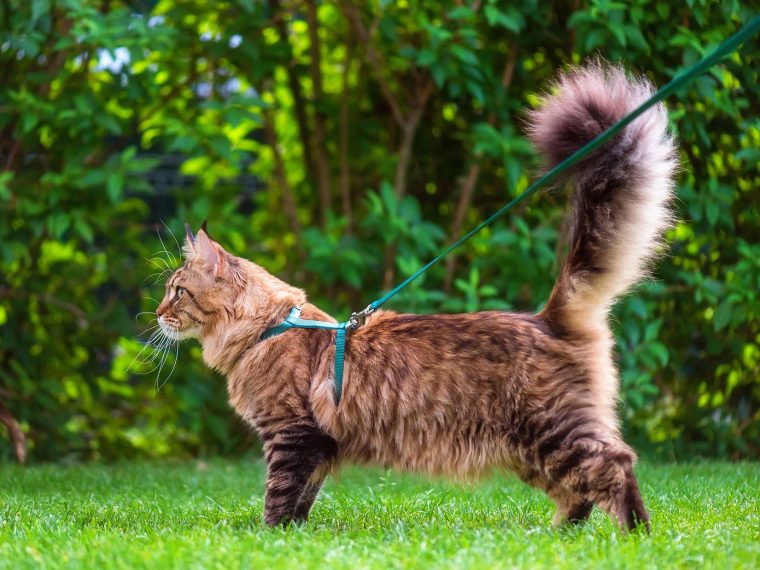Free-roaming cats have it good: they can hunt, explore their territory, nibble on fresh grass whenever they want, and socialize with other cats. It is therefore understandable that city dwellers who keep house cats also worry about whether their furry friend would like to get to know nature. Could walking your pet be the solution?
Table of Contents
Taking the cat for a walk: No comparison to real freedom
The fact is: when walking on a leash, house cats are less able to express their natural urges and movement patterns than when they go outside or run in the garden. It restricts the cat but that doesn’t mean that walking the cat can’t be enriching – after all, the animal gets to know nature and gets a taste of fresh air. The alternative for indoor cats would be a balcony secured by a net.
The character of the cat is crucial
Many cat owners fear that walking on a leash will harm their cat rather than do it any good. The concern is partly justified. Very stubborn and freedom-loving animals could actually develop a restlessness in their living space after they get to know nature. It depends on the cat in question. In addition, some animals are completely satisfied with their protected environment and tend to be frightened by excursions. In this case, cat owners should respect their kitty’s wishes and refrain from the idea of going outside.
Walking the cat: great idea or unnecessary stress?
The topic of walk a cat divides opinions. For some it’s a great idea, for others it’s pure animal cruelty.
A walk on a leash can be a wonderful way to show domestic feline the big wide world at least now and then. For some, it sounds more like animal cruelty to force such a freedom-loving animal into a harness. The truth – as so often in life – lies somewhere between these two extremes and as a super dosi you are on this page to form an informed opinion. Your pet will thank you!
Admittedly, most house cats initially react very negatively to a harness. For some cats, this may be an indication that it is better not to do so. But for others it is just an initial shyness that can be overcome with empathy and patience.

Pros and cons
The annoying foreign body that a cat initially perceives the harness to be can, after a while, become a ticket to exciting outdoor adventures. As controversial as dog walking may be, there are many cat owners who are committed dog walkers – and their happy indoor cat on a harness is the best proof of this. Cats are essentially not pets, but rather strays, which in nature sometimes travel long distances a day. They want to move, explore their surroundings, explore the many smells and sounds of this world. Of course, all of this is only possible to an extremely limited extent within the four walls of home.
On the other hand, and experts confirm this, indoor cats don’t miss anything if they are used to living in the house from an early age. These animals love security, safety and routine. That’s why walking the dog can turn into pure stress and unfortunately it also harbors some dangers. Dogs, sudden noises, cyclists – all of these things can frighten kitty and cause her to scramble out of her harness in a panic.
The cat on a leash
Above all, it is important to know the individual character of the cat and to take it into account. Every cat is different and has different needs, and experienced Super-Dose users are of course aware of this. The mere desire to walk around outside with your furry roommate should not be given more weight than the cat’s well-being. You know your pet best, so ask yourself: Would walking my cat be fun and am I willing to invest the time, money and effort into it? If the answer is yes, then there are a lot of things that should be taken into account to ensure that the “cat on a leash” adventure does not turn into a disaster.
The scent of freedom
Some cat owners have already experienced their blue miracle: After their feline had been outside on a tether or with a collar a few times, she suddenly vehemently demanded a walk. Anyone who decides to dare to go on this adventure with their velvet paw should be safe. Because there may be no going back. And if you don’t have the time or inclination anymore, you’re definitely not going to be happy about scratched furniture and other “protest actions” and, above all, you’re making your animal roommate very unhappy. Who wants that anyway? Definitely not a super dose.

The right cat harness
If you want to embark on the adventure of taking your cat for a walk, the first thing you need to do is buy a cat tether. Here it is important to take good measurements and take the cat’s peculiarities into account. While a dog will accept pretty much any leash, things are a little more complicated for sensitive kitties.
How to put on a cat harness
Before the tether is even put on, the cat must have the opportunity to get to know the foreign object. To do this, simply place it in a place where kitty will eventually stumble over it by itself. This way the animal can sniff and explore that the tether doesn’t mean anything bad.
The next step is putting on the tether. The leash can be dispensed with for now. Choose a moment when your cat is completely relaxed and combine every single step with extensive praise. It is important for a super dose not to force anything. One or two treats sweeten the cat’s training. Once the tether is in place, you can distract your animal. When playing a little game, kitty may even forget the dishes altogether and if not, don’t worry if she stumbles around with them at first. She has to get used to the extra weight first.
If putting it on goes smoothly, then the leash can also be added. Show your darling around the apartment or, better yet, let him guide you. After a while it will become normal for the cat to move around on a leash. Now is the time to take your first steps outside.

The big wide world
At first, a few steps outside the door are enough. Little by little more territory can be conquered. Don’t forget: The cat should have been vaccinated and neutered before its first long walk.
A super dose tip: Take your pet’s usual transport box or basket with you when you walk your cat. Then there is always a safe place to retreat should something unexpected happen and they get frightened. The best place for walks together is a clear meadow without too many trees. Of course it can’t be a dog park.
Cat owners have to be aware that the cat goes for a walk with them, not them with their cat. A cat on a leash is still a cat and not a dog, so it will set the tone. The attentive velvet paws want to explore everything in detail and need time to do so. You also have to be allowed to just sit, look, smell and listen. Unlike dogs, cats like to move from one safe place to the next and pause there. So, above all, be patient when you take your cat for a walk, then you will give your pet unforgettable moments and prove to be a real super treat.
The cat takes the person out – not the other way around
A crucial difference to the traditional walk with the dog: cats are hurdle runners. They have a different movement pattern than dogs and, for example, prefer to run from hiding place to hiding place. Sometimes a cat will stand still for minutes and then start running the next moment. You follow the animal rather than pulling and trying to dictate direction.
But be careful: cat owners should not let their leashed cat climb trees. The risk of the line getting caught in the branches and the animal strangling itself is too great.
With the house cat outside: What if the house cat gets loose?
Many cat owners also fear that their pet might get loose on a leash during a walk and no longer find its way home. The danger is always there. However, you can counteract this by initially only taking the animal out when it is hungry. This increases the chance that cat owners will respond when you call them back. Also important: mark the animal with a microchip and have it registered so that it can be identified in case of doubt.
FAQs
Q: Can you walk your cat?
A: Yes, you can walk your cat using a tether and leash designed for cats. It’s a great way to let your cat explore the outside safely.
Q: Are tether and leash necessary for walking a cat?
A: Yes, tether and leash are essential for walking your cat as it provides control and safety for both you and your cat.
Q: Is it safe to let your cat go outdoors?
A: Allowing your cat outdoors can expose them to potential threats like fleas, ticks, and other animals. Walking your feline on a tether can be a safer alternative.
Q: How can you train your cat to walk on a leash?
A: You can start by getting your cat walk used to the tether and leash indoors before venturing outside. It’s important to be patient and persistent in the training process.
Q: Do indoor cats need to be walked outside?
A: While indoor cats may not need to go outside for exercise, walking them outdoors can provide mental stimulation and enrichment.
Q: What are the potential risks of walking a cat on a leash?
A: Cats have a strong instinct to explore and may try to escape their tether. It’s important to be vigilant and always supervise your cat while walking them outside.
Q: How can you ensure your cat’s safety while walking them outside?
A: Make sure your cat’s tether fits properly and is secure. Also, avoid busy roads and areas with potential dangers like aggressive animals.